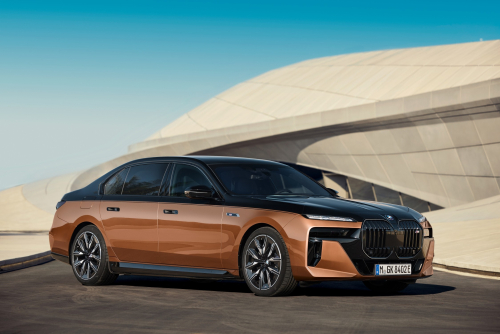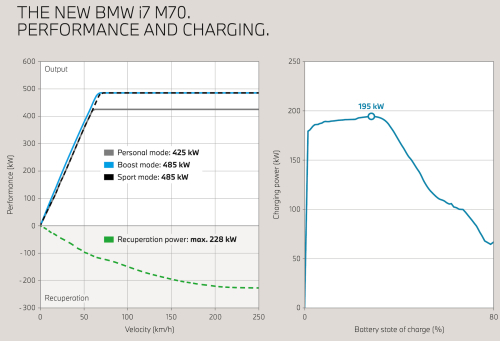
The new BMW i7 M70 xDrive features an electric motor at both the front and rear axle generating a maximum system output of 485 kW/660 hp and an M-specific chassis. The range-topping model of the new BMW 7 Series line-up accelerates from 0 to 100 km/h (62 mph) in 3.7 seconds, making it the fastest all-electric BMW model. Top speed is electronically limited to 250 km/h (155 mph).
Following the launch of the BMW i4 M50—BMW M GmbH’s best-selling model worldwide in 2022—and the BMW iX M60, this is now the company’s third performance model to have an all-electric drive system.
The BMW i7 M70 xDrive will be built at BMW Group Plant Dingolfing, together with all other model variants of the luxury sedan. As well as being the lead plant for luxury models, the production facility is also home to the competence center for electric drive system production, which manufactures both the electric motors and the high-voltage batteries for all variants of the BMW i7 on site. The worldwide launch of the BMW i7 M70 xDrive will start in the second half of 2023.
The two drive motors work according to the principle of an electrically excited synchronous motor. This type of design makes it possible to completely avoid the use of rare earth metals (required for magnetic components) in the manufacture of the rotor.
An M-specific configuration of the drive system enables the BMW i7 M70 xDrive’s rear-axle motor, in particular, to achieve unprecedented levels of power density. The drive unit has a six-phase design with a dual inverter. This forms the basis for a very substantial increase in peak output that remains on tap up to high speeds, endowing the BMW i7 M70 xDrive with the power delivery characteristic of M models.
The motor’s power density of 2.41 kW/kg represents an increase of 25.5% over the unit that drives the rear axle of the BMW i7 xDrive60—meaning that the BMW i7 M70 xDrive is fitted with what is currently the company’s most powerful electric motor.

The new BMW i7 M70 - Performance and charging.
This new standard-setting figure can be attributed to a BMW Group-patented innovation developed under the umbrella of BMW EfficientDynamics, which uses six excitation windings in the motor’s stator instead of the customary three. The resulting “double excitation” compared with conventional units allows the electric motor to generate an extremely high output, despite its exceptionally light and compact design, and to maintain it continuously into the higher echelons of the speed range. This solution is also superior to a drive configuration using two motors at the rear axle in terms of both power density and efficiency, BMW said.
The motor powering the rear axle generates peak output of 360 kW/489 hp. Its precisely coordinated interaction with the 190 kW/258 hp motor at the front axle creates an electric all-wheel-drive set-up generating system torque of 1,015 N·m (748 lb-ft) in Sport mode and as much as 1,100 N·m (811 lb-ft) when M Launch Control or the M Sport Boost function is activated. The drive system in the BMW i7 M70 xDrive therefore offers outstanding pulling power.
Capable of sprinting from 0 to 100 km/h (62 mph) in 3.7 seconds, the BMW i7 M70 xDrive is the fastest purely electrically powered BMW model. The performance characteristics of the drive system are also characterised by sustained power delivery, which ensures rapid speed increases even in higher speed ranges.
With the M Launch Control function, both drive and traction control are integrated into the engine control unit. This ensures the power generated by the electric motors is metered extremely precisely, allowing the drive system’s M-typical performance characteristics to be instantly converted into stunning acceleration without any loss of traction.
Located in the vehicle’s underbody, the battery provides 101.7 kWh of usable energy. This gives the BMW i7 M70 xDrive a range of 488 – 560 kilometers (303 – 348 miles, WLTP cycle). The Combined Charging Unit features advanced charging software designed for charging the high-voltage battery faster and more efficiently. The BMW i7 M70 xDrive is capable of AC charging at up to 22 kW as standard, while DC power can be taken on board at a rate of up to 195 kW. This means the range can be extended by as much as 170 kilometers (106 miles, WLTP) in just ten minutes during a mid-journey stop at a high-power charging station.
The car’s range can be extended while on the move by activating a new drive system setting. The launch of the BMW i7 M70 xDrive marks the introduction of a MAX RANGE mode for the all-electric models in the new BMW 7 Series range. In this mode, drive power and top speed are carefully restricted and comfort functions scaled back, allowing range to be increased by some 15 to 25%.
The MAX RANGE mode was mainly devised for situations where drivers are unable to recharge mid-journey as originally planned because, for example, the charging station they were heading for is out of service.
Standard specification for the BMW i7 M70 xDrive includes M‑specific adaptive two-axle air suspension with electronically controlled dampers and automatic self-levelling. M-specific air springs with reduced volume and an adapted rolling contour increase the number of vibrations on the front and rear axles by six in each case and provide a noticeably direct connection to the vehicle body. M-specific hydraulics are also used to optimize damper response.
An additional shear panel between the bulkhead and spring strut towers produces a substantial increase in body rigidity at the front end of the BMW i7 M70 xDrive. Also to be found on the standard equipment list are Integral Active Steering and the Executive Drive Pro chassis package including active roll stabilisation with Active Roll Comfort. As well as helping to increase comfort, these two systems—together with the stiffer body—hone the car’s handling dynamics. This translates into an appetite for corners, which are taken with sharp and precise turn-in characteristics.